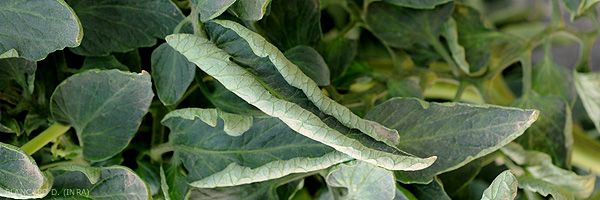
Physiological leaf curl
The symptom of leaf curl ( leaf roll ) can occur on young plants produced under shelter and implemented in the field during wet periods. It is generally observed later, on plants with at least 3 bouquets and in the summer period. It is first and foremost the lower leaves of plants grown in the open field, and to a lesser extent under shelter, which are affected. The leaf blades gradually curve upwards and sometimes inexorably (Figures 1 and 2); eventually, the opposite edges of the leaf blade meet and the leaflets are eventually fully rolled up on themselves (Figures 3 and 4). In the end, the fabrics are often thicker, crisp and shiny. In some particularly severe situations, a high proportion of the leaves are affected, giving the plants a special appearance.
The direct impact of these symptoms on plant development and production is often low. In some severe cases, the particularly exposed fruits will be more vulnerable to solar radiation and burns may be observed ( Sunburn - sunscald ).
This physiological disease is very common. It is influenced by climatic conditions, cultural practices and cultivated varieties. It occurs above all when the plants are loaded with fruit and / or when they are subjected to particular climatic or agro-cultural conditions disturbing the foliage-roots balance and / or the water supply of the plants: period of prolonged drought, momentarily wet soil at the following heavy rains or of an asphyxiating nature, too severe pruning of plants, excessive application of nitrogenous fertilizers, destruction of roots following cultural interventions. Very common in amateur gardens, it is also found among experienced producers. Note that we can see differences in sensitivity between varieties in the field, but none of them is totally resistant to this non-parasitic disease.
A number of measures are recommended to avoid this problem:
- plant in well-drained soil;
- ensure balanced fertilization, in particular avoiding excess nitrogen;
- do not carry out agro-cultural interventions in dry weather;
- irrigate regularly so as to maintain constant soil moisture, avoid infrequent and too large additions;
- mulch the soil.
It should be noted that the windings of tomato leaflets have been associated with high levels of CO 2 under shelters.
The direct impact of these symptoms on plant development and production is often low. In some severe cases, the particularly exposed fruits will be more vulnerable to solar radiation and burns may be observed ( Sunburn - sunscald ).
This physiological disease is very common. It is influenced by climatic conditions, cultural practices and cultivated varieties. It occurs above all when the plants are loaded with fruit and / or when they are subjected to particular climatic or agro-cultural conditions disturbing the foliage-roots balance and / or the water supply of the plants: period of prolonged drought, momentarily wet soil at the following heavy rains or of an asphyxiating nature, too severe pruning of plants, excessive application of nitrogenous fertilizers, destruction of roots following cultural interventions. Very common in amateur gardens, it is also found among experienced producers. Note that we can see differences in sensitivity between varieties in the field, but none of them is totally resistant to this non-parasitic disease.
A number of measures are recommended to avoid this problem:
- plant in well-drained soil;
- ensure balanced fertilization, in particular avoiding excess nitrogen;
- do not carry out agro-cultural interventions in dry weather;
- irrigate regularly so as to maintain constant soil moisture, avoid infrequent and too large additions;
- mulch the soil.
It should be noted that the windings of tomato leaflets have been associated with high levels of CO 2 under shelters.





